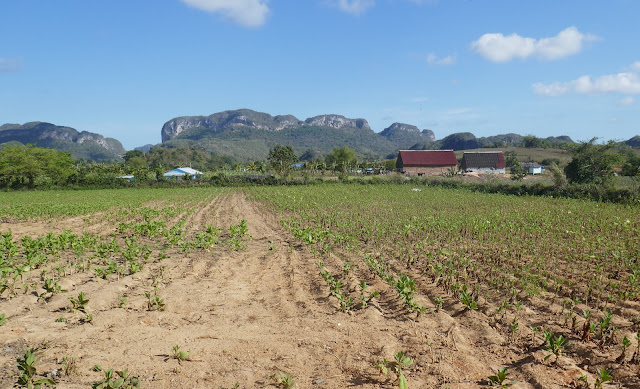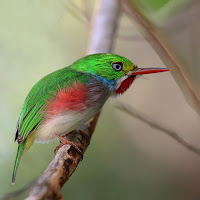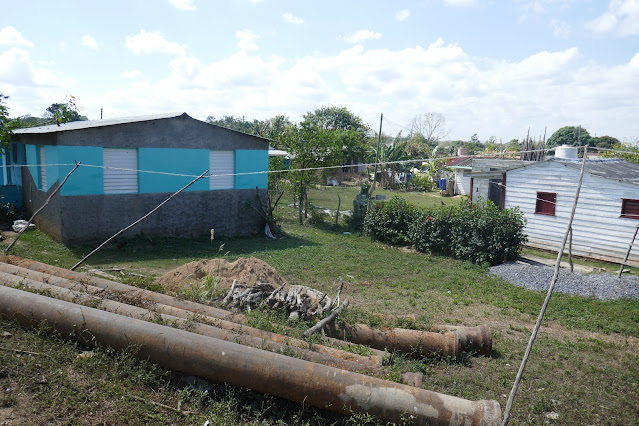From the Straits of Florida to the Caribbean Sea
Leaving Viñales
 |
| Cuba |
With an early start, breakfast was booked for 5.30. Basita rose to the challenge, had everything ready on time and even produced cheese
and ham buns for lunch on the journey.
Our taxi was booked for 6.30, at 6.31 Basita was on the phone asking where it was. It arrived soon enough after that. Before we said our goodbyes she requested the travel company’s voucher for our accommodation and one dinner; she did not ask for any payment for our lunch on arrival, the
beer with that dinner, the coffee and biscuits yesterday afternoon or today’s packed
lunch. We folded a tip inside the voucher, if we had given it openly she might possibly have refused.
 |
| Lynne and Basita, Casa Basita, Viñales |
If you ever find yourselves in Viñales, we can recommend Casa Basita!
Five-minutes later we reached the town square where there was a bus with ‘Trinidad’ prominently displayed on its windscreen. We joined the queue to place our baggage in the hold, but when our turn came the driver looked at our tickets and shook his head.
 |
| Viñales is just north Pinar del Rio in western Cuba. The journey to Trinidad on the south coast is about 500 km |
We had not previously noticed, but a disconsolate looking
group was gathering across the road. We mooched over and compared tickets and
destinations. ‘Wrong bus company’ somebody said gesturing at the vehicle that
had rejected us all. Our group grew a little and after a mildly worrying ten
minutes a large cheerful man arrived and led us round the corner to where the right
company’s bus was hiding.
Viñales to Cienfuegos
We left ten minutes later than the 7 o’clock schedule, not because of the initial confusion but because of an absent passenger. Neither bus was full, perhaps the European Covid lockdowns were dragging people home and preventing new arrivals replacing them.
‘I’m Joel,’ the cheerful fellow said as we set off, ‘and I’m a singer, like Billy Joel, but with less money, so I do this job, too.’ Not
that he did much; at stops he told us for how long, and he announced our
destination but, that apart, he was along for the ride.
And it was a particularly interesting ride. For the first couple of hours we retraced our steps from two days ago, back to Pinar
del Rio and along the Autopista Este-Ouste to the outskirts of Havana. The
autopista runs through flat agricultural land – there was little to look at on
the way out, and no more on the way back.
Then we turned south and stopped for coffee.
 |
| We stopped for coffee, but garlic was also an option! |
After that there was a little more to look at….
 |
| Rural Cuba, not the most exciting image, but the views were improving |
…but not a lot. We stopped for lunch at a large, smart purpose-built restaurant and services complex. Joel and Benito, the driver, went off for some chicken and rice but we were dining at our B&B and experience
suggested it would not be a snack. A meal was out of the question, so like most
of our fellow passengers, we had a beer and wandered round until it was time to
leave and then ate our cheese and ham buns on the bus.
 |
| We had a nice, clean, comfortable bus to travel on |
Again it was not a particularly interesting drive…
 |
| A colourful spot on the way to Cienfuegos |
….until we reached Cienfuegos.
 |
| Cienfuegos |
Cienfuegos
The capital of a province of the same name, Cienfuegos is one of Cuba’s most important industrial centres and ports. The population is
quoted as 160,000 but Cuban population figures are always for the ‘municipality’, a much
larger area than the city, which looks a small, tidy settlement on aerial
photographs. ‘Cienfuegos’ means ‘100 fires’ but it was named after José Cienfuegos,
Captain General of Cuba 1816-19 not a conflagration. Camilo Cienfuegos, one of
the leaders of the revolution along with the Castro brothers and Che Guevarra, is revered but has
no particular connection with the city.
We stopped to drop off a group of passengers near the pedestrianised centre which looked clean and well-maintained.
 |
| Central Cienfuegos |
To those passing through, the city looked pleasant, even affluent, though as we turned onto the Circuito Sur which would take us the
last 80km to Trinidad, the vehicles coming towards us were a scooter, three horse
drawn taxis and a bus.
 |
| Cicuito Sur, Cienfuego - one scooter, three horse drawn taxis and a bus |
Cuban-American Relations (2)
A poster at the exit of the town boasted that Cuba would smash the American blockade. This has prompted Cuban-American Relations
(2). Part 1 can be found in Havana
to Viñales.
 |
| Smash the bloqueo, Cienfuegos |
I will spare you the tortuous story of how Cuba finally wrested its independence from Spain in 1902, with the not-entirely altruistic
assistance of the USA. Cuban democracy was always a sickly child, struggling
with a series of armed insurrections and American interventions. Meanwhile, Havana
became an American tourist centre, particularly during Prohibition, and that
brought gambling, prostitution and corruption in its wake.
 |
| Fulgencio Batista in 1940 |
The Great Depression saw sugar prices drop and take Cuba’s shaky democracy down with them. The 1933 Sergeants' Revolt brought power to Sergeant
Fulgencio Batista who ruled through a series of puppet presidents before becoming
president himself in 1940.
Leaving office in 1944 he went to Florida, returning for the 1952 Presidential Elections. Realising he could not win the vote, he staged a coup and became President anyway.
Back in power, Batista allowed
American companies to plunder Cuba’s resources, particularly the sugar industry,
while enriching himself from the proceeds of organised crime. Unrest caused by high unemployment made him vulnerable
to a counter-coup and even US President Eisenhower realised that Cuba would be
better off without him.
It was time for a revolution – which brings us to Part 3, later.
The Caribbean Sea
The Circuito Sur wandered inland for 50 minutes before heading for the coast. Cuba has coastlines on the Atlantic Ocean, the Straits of
Florida, the Gulf of Mexico and the Caribbean Sea, though precisely where one stops
and the next starts is negotiable. The waters round Havana are ‘Straits of
Florida’, but the south coast is incontrovertibly Caribbean and we had our
first glimpse as the road descended towards Yaguanabo. The sea is clearly blue, but I shall generalise no further from this one little
corner.
 |
| The Caribbean at Yaguanabo |
Trinidad and Hostal Maidys
 |
| Trinidad de Cuba |
Half an hour later we were in Trinidad de Cuba, though ‘de Cuba’ is only added when there is a possibility of confusion with the large
island at the other end of the Caribbean.
Trinidad is not a large town and the bus was soon parked at Plaza Carillo, the town centre. We were met by a young man who led us
round the corner to his cycle rickshaw.
 |
| Cycle Rickshaw and driver, Trinidad |
From the plaza in the New Town he took us to Calle Gloria in the Old Town, a UNESCO World Heritage Site. The distance was only a couple
of hundred metres but it was all uphill – not steep but steadily rising – and the
Old Town is cobbled.
 |
| Calle Gloria, Trinidad Old Town |
Pedalling a heavily laden, single-gear bicycle uphill over old, uneven cobble was hard work and we made slow progress but the young
man remained cheerful and obliging, carrying our bags into Hostal Maidys for
us.
 |
| Hostal Maidys, Calle Gloria, Trinidad |
Maidy, like Basita in Viñales, was the lady in charge. Behind the narrow, pastel-painted and well-fortified façade, the house goes
back a long a way. There is a family lounge inside the door, beyond that a
well-equipped kitchen and then an atrium with potted palms and other plants and two guest rooms
off. Upstairs were two more rooms a railing round the atrium and a dining area with
four tables. There must be accommodation for Maidy and her family, too, but I
am not sure where it was.
The Baleful Influence of Covid 19
A phone call from our local agents informed us of new arrangements for returning home. Today was Wednesday, we were originally booked
to return next Tuesday, but with flights being cancelled, our British agents had
found us a flight on Friday. I had expressed my displeasure at losing so much
of our trip. The new version had us leaving on Monday, sacrificing only
our second day at a coastal resort.
Having established all at the B&B was to our liking we went out to find a café with free wifi or, failing that, a hot-spot
where we could use the internet card we had bought in Havana to email our
British agents and accept the new flights. There was no obvious café, but there
was an obvious hot spot and the deed was done.
 |
| Spot the wifi hot-spot, Trinidad |
As this was our fourth full day, we had developed a routine – we tend to do that sort of thing – and the routine demanded we drop
into a appropriate café for a late afternoon cocktail. So we did.
 |
| I did not need a shirt, I just borrowed one of the table cloths |
Dinner with Maidy
The temptation to compare Maidy with Basita in Viñales
was strong, but unfair on Maidy; Basita was incomparable. Maidy was welcoming
and efficient and all you would normally hope for in a B&B owner. She produced
a good three-course meal for six on time and without fuss.
We dined with a Swedish couple who had arrived just after us, and a British couple who had been there a few days. He was having the
holiday from hell – and she was long-suffering. A pre-existing condition had flared up while he was in Cuba and he had seen the inside of a hospital or two. He seemed a little dismissive of Cuba’s usually highly regarded medical
services and was desperate to go home, but so far he had only been offered an
Aeroflot flight via Moscow in a week's time.
Maidy provided squash soup, fried fish with sweet potatoes and salad followed by ice-cream. It was a big slab of meaty fish – marlin
was the consensus view. We had eaten marlin once before, in one of the themed dinners
we used to attend in the Reform Tavern, Woodseaves, now long demolished – a few
others might remember those.
Part 1: Havana
Part 2: Havana to Viñales
Part 3: Walking the Viñales Valley
Part 4: Viñales to Trinidad de Cuba
Part 5: Trinidad (1) The Town
Part 6: Trinidad (2) Valle de Los Ingenios
Part 7: Santa Clara and Che Guevara
Part 8: Jibacoa and a Strange Trip Home








































